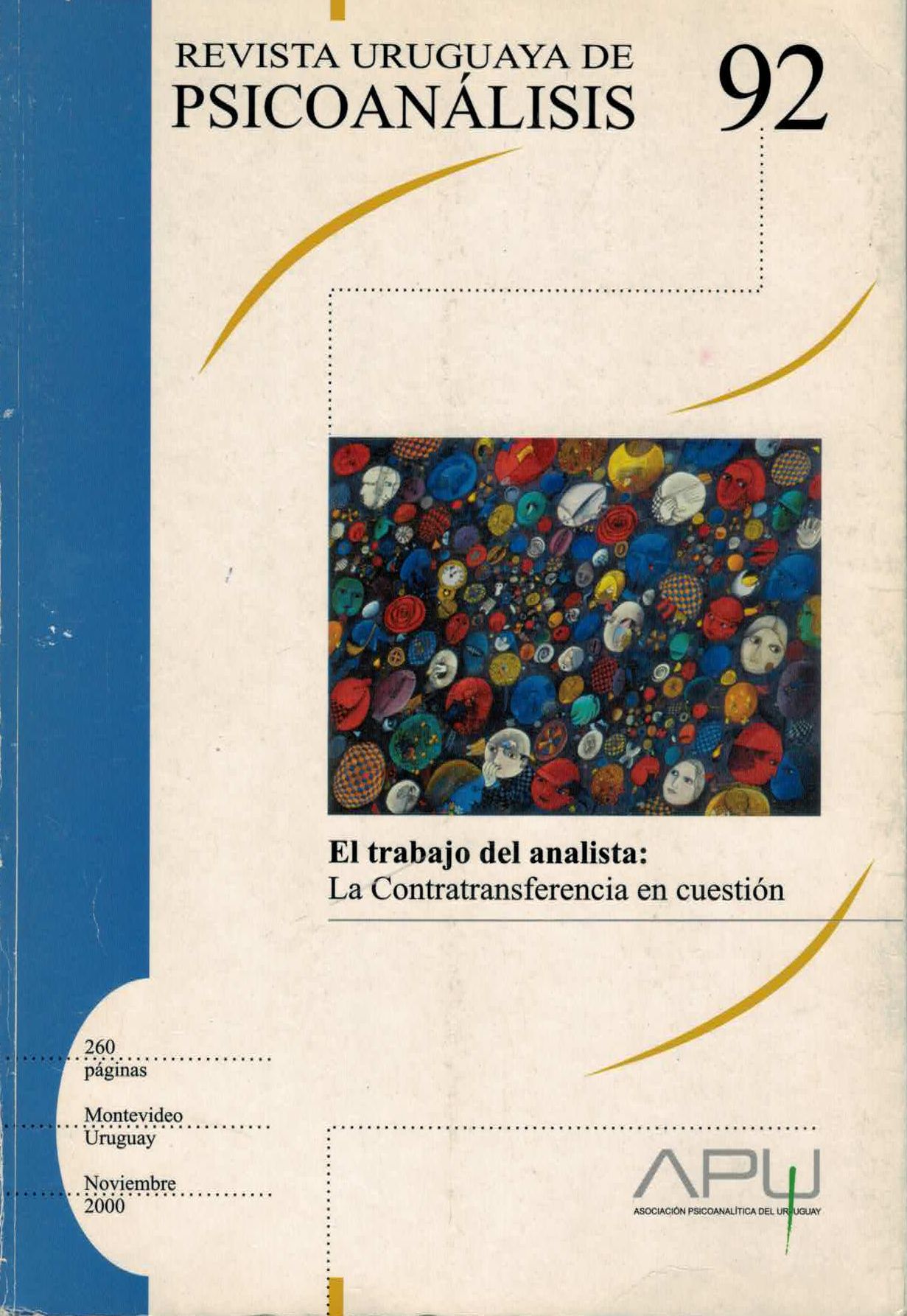Acute enactment (staging) as a 'resource' for the unveiling of a collusion of the analytical duo.
Keywords:
proceso psicoanalítico, baluarte, actuación, enactment, contratransferencia, material clínicoAbstract
The objective of the paper is to discuss some aspects related to the functions of enactments in the analytical practice. After a review of the concept, a borderline patient, with whom the analytical process seemed to be developing productively, is described.
Following a change in the setting, an intense, acute enactment took place. Its understanding enabled to realize that the analytical couple were involved in an unconscious collusion, where a symbiotic relationship had been established between the
patient, the analyst and his family, as a chronic enactment. That relationship prevented the analyst from touching highly destructive unconscious fantasies and archaic traumatic situations. The comprehension of the enactment enabled the dissolution of the
collusion. It is proposed that, besides the resistance aspect, the collusion may have been useful to strengthen the patient’s mental mechanisms and the trust in the analytical work, which demanded certain time. The acute enactment arises, unveiling the collusion, when the patient and the analyst feel able to face the terrible feelings related to the triangular situation.
It’s speculated that both enactments may occur in the analysis of these kind of patients, and their function is to re-lived their archaic experiences in the analytical process, also with the aim to elaborate them. It’s also proposed some differences between the “acting-out” and “enactment” concepts, emphasizing the obstructive aspects in the first, and the communicative aspects in the second. Finally, it’s proposed a classification of enactments: normal, pathological, acute and chronic enactments.
Downloads
References
BARANGER, M. & BARANGER, W. (1969). Problemas del campo psicoanalítico. Buenos Aires: Kargieman.
BATEMAN, A.W. (1998). Thick and thin-skinned organisations and enactment in borderline and narcissistic disorders. Int. J. Psychoanal. 79, 13.
BION, W.F. (1959). Attacks on linking. Int. J. Psychoanal. 40:308. (También en Estudos psicanalíticos revisados. Second Thoughts. Rio: Imago, 1988, pp. 87-100).
_______ (1962). Learning from experience. London: Heinemann.
BOESKY, D. (1982). Acting-out: a reconsideration of the concept. Int. J. Psychoanal.63: 39-55.
BRITTON, R. (1999). Getting on the act: the hysterical solution. Int. J. Psychoanal.80:1.
CASSORLA, R.M.S. (1993). Complexo de Edipo, vista grossa, curiosidade e catástrofe psicológica. Rev. Bras. Psicanál. 27(4): 607-626.
_______ (1997). No emaranhado de identificações projetivas cruzadas com adolescentes e seus pais. Rev. Bras. Psicanál. 31(3): 639-676.
CHUSED, J.F. (1991). The evocative power of enactments. J. Amer. Psychoanal. Assn. 39: 615.
DUNN, J. (1995). Intersubjectivity in psychoanalysis: a critical review. Int. J. Psycho- Anal. 76 (4): 723.
FELDMAN, M. (1997). Projective identificaron: the analyst’s involvement. Int. J.Psychoanal. 78: 227.
_______ & SPILLIUS, E.B. (Org.) (1989) Psychic Equilibrium and Psychic Change. By Betty Joseph. London: Routledge.
FERRO, A. (1992). La técnica nella psicoanalisi infantile. Milano: Raffaello Cortina.
GABBARD, G.O. (1995). Countertransference: the emerging common ground. Int. J.Psycho-Anal. 76:475-485.
GRINBERG, L. (1957). Perturbaciones en la interpretación por la contraidentificación proyectiva. Rev. Psicoanál. 14:23.
_______ (1982) Más allá de contraidentificación proyectiva. Actas XIV Congreso Latinoamericano de Psicoanálisis.
HINSHELWOOD, R.D. (1999). Countertransference. Int. J. Psychoanal. 80: 797.
INTERNET SITE DISCUSSION (1998). Thick- and thin-skinned organisations an enactment in borderline and narcissistic disorders, by Anthony W. Bateman (by Paul Williams). Int. J. Psychoanal. 79: 631.
JACOBS, T.J. (1986). On Countertransference enactments. J. Amer. Psychoanal. Assn.34:289.
_______ (1999). Countertransference past and present: a review of the concept. Int. J.Psychoanal. 80: 575.
KUMIN, I. (1996). Pre-object relatedness: early attachment and the psychoanalytic situation. New York: Guilford Press.
McLAUGHLIN, J.T. (1991). Clinical and theoretical aspects of enactment. J. Amer. Psychoanal. Assn. 39: 595-614.
_______ & JOHAN, M. (1992) Enactments in psychoanalysis. J. Amer. Psychoanal. Assn. 40: 827-841.
OGDEN, T. H. (1982). Projective Identification & Psychotherapeutic Technique. New York and London: Jason Aronson.
_______ (1994a). The analytical third: working with intersubjective facts. Int. J. Psycho-Anal. 75: 3-19.
PANEL (1999). Enactment: an open panel discussion. J. Clin. Psychoanal. 8: 3-82.
ROSENFELD, H. (1987). Impasse and interpretation: therapeutic and anti-therapeutic factors in the psychoanalytic treatment of psychotic, borderline, and neurotic patients. London: Tavistock Publ.
ROUGHTON, R.E. (1993). Useful aspects of acting-out: repetition, enactment and actualization. J. Amer. Psychoanal. Assn. 41: 443-471.
SANDLER, J. (1976). Countertransference and role-responsiveness. Int. Rev. Psycho-Anal. 3:43-47.
_______ (Ed.) (1987). Projection, Identification, Projective Identification. Madison: International University Press.
STEINER, J. (1993). Psychic retreats. London: Routledge.
THOMÄ, H. & KÄCHELE, H. (1985). Teoría y Práctica del Psicoanálisis. Fundamentos. Barcelona: Herder, 1989.



 This work is licensed under a
This work is licensed under a 